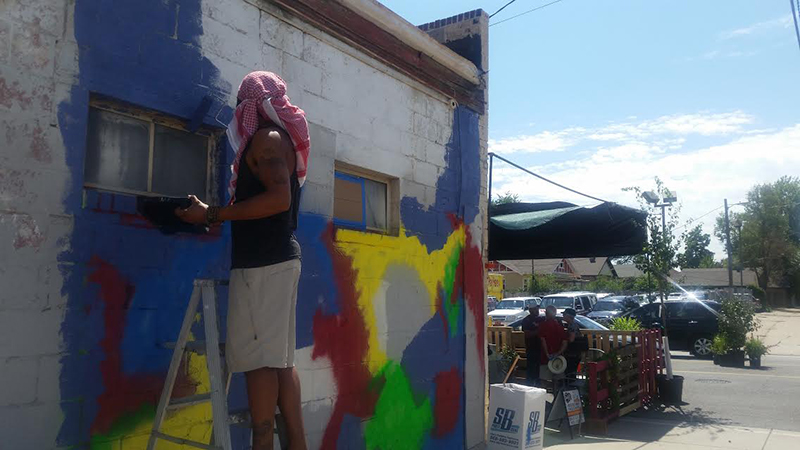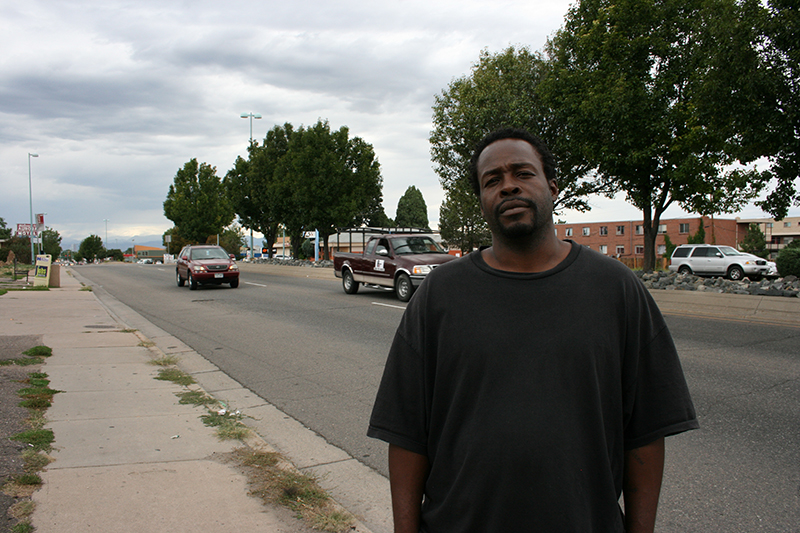
Colfax was built for cars, but planners and activists are trying to make it walkable. Photo by Kristin Jones
Colfax was built for cars, but planners and activists are trying to make it walkable. Photo by Kristin Jones
The place where you live—the actual, physical space—makes a difference to your health and prosperity. That’s the takeaway from all kinds of research; neighborhoods affect how easily people can move out of poverty, how they relate to each other, how safe they feel, and how physically active they are.
Here in Denver, the physical space that perhaps most captures the hopes and angst of residents and urban planners is Colfax Avenue.
Once the major east-west thoroughfare in the city, Colfax was a fine place when it showed up in Jack Kerouac’s On the Road: a spot to hit the bars while searching for grown-up Denver street urchin Dean Moriarty, and then retire to a friend’s parents’ swank apartment.
Yet by 1978, when columnist George Will arrived—after I-70 had stolen Colfax’s mantle as the east-west interstate—he declared that the threat of nuclear annihilation “loses some of its sting when you see Denver’s Colfax Avenue.” In the decades that followed, East Colfax solidified its reputation for drugs, prostitution and violence.
The street hasn’t gotten any less polarizing.
Last month, the West Colfax Business Improvement District held a small street fair at the intersection of West Colfax and Utica in Lakewood, erected at the site of a shuttered day-labor service sandwiched between a truck dealership and an elementary school. The point of the event was to “Re-Imagine West Colfax” as a street that is friendly to pedestrians and bikers.
It certainly took some imagining: as it stands, West Colfax can feel like an endless stretch of auto body shops and fast food franchises. The organizers put up potted plants to simulate a tree-lined sidewalk, painted a crosswalk and added a bike lane. There were free samples of Little Man ice cream (salted Oreo, Mexican chocolate, and toasted coconut sorbet) and a flamenco band. Artist Ian Kane painted a mural while we watched.

Michael Russell, whose small custom furniture studio and home have been at that intersection for the past eight years, says he can see West Colfax becoming walkable and bikeable. He has already noticed the neighborhood changing, with some of the car lots disappearing and other businesses moving in. Nearby, the former site of St. Anthony’s Hospital is being reconceived as a pedestrian-friendly spot with shops, restaurants and bars.
“It might take eight to 10 years, but it’s gonna happen,” says Russell.
That might sound ambitious if you’ve ever walked on Colfax, an avenue built by and for cars. Ken Schroeppel, an urban planner at the University of Colorado Denver, points out that the avenue is a reflection of policy decisions in the post-World War II automobile era, ruled by drive-through restaurants and the parking lots of businesses catering exclusively to motor vehicles.
Add to that the challenge that Colfax remains a state highway, under the jurisdiction of the Colorado Department of Transportation, whose primary objective is “moving the maximum amount of cars from Point A to Point B,” says Schroeppel. “It’s no surprise that we end up with this automobile-dominated mess that’s not walkable or bikeable.”
Still, Schroeppel is an optimist. He points to East Colfax near the Capitol. Zoning changes in the past decade scrapped the outdated requirement that businesses be set back from the road, and allowed for residential development.
There are now stretches of Colfax that fulfill the three requirements for a walkable street, Schroeppel says: decent pedestrian infrastructure, like lighting; interesting things to look at, like storefront windows and restaurant patios; and genial physical characteristics, like buildings that come right up to the sidewalk instead of skulking in the background.
“If you’ve got those three things,” he says, “you’ve got a good chance.”
I live and work close to the part of Colfax that’s being redeveloped in the way Schroeppel describes. You can see the changes in architecture wrought by zoning changes and gentrification. At Colfax and Pearl, for instance, is a stretch of road that fits the new standards. On the north side, the Colorado Coalition for the Homeless built the handsome Renaissance Uptown Lofts as affordable housing in 2010. It’s across the street from the Cheeky Monk Belgian Beer Cafe, whose logo “Belgium’s Oldest Tradition on America’s Longest, Wickedest Street” capitalizes on Colfax’s seedy reputation.
The businesses there have had mixed success. The Cheeky Monk has done well enough for its owners to open the Lost Highway Brewing Company next door. But Pizza Fusion, which the Coalition ran in the storefront under its lofts as a job-training and employment initiative for homeless Coloradans, couldn’t make a go of it and closed last month. A lot of the nearby businesses are chains: McDonald’s, 7-Eleven, Office Depot.
Phil Goodstein is a local historian who gives walking tours in Denver—precisely the kind of person who might be expected to benefit from a more walkable, tourist-friendly town. Count him among Colfax’s discontents.
“My view of the street is extremely negative,” says Goodstein. “It is a very boring street. It is a very hard street on which to walk.”
But he thinks city planners should save taxpayers’ money by leaving Colfax alone instead of “trying to turn it into Cherry Creek North,” Goodstein says. “Colfax has generally succeeded by being a low- to moderate-income area.”
Just a block or two to either side of this part of East Colfax, the leafy streets are beginning to tell a different story. Rents and housing prices have soared as the allure of downtown living—precisely the kind of compact, healthy lifestyle touted by urban planners—has drawn in millennials and young families like mine. I grew up in the Centennial (then Englewood) suburbs, but lived in New York for nine years. When my husband and I moved here, we were looking for a place where we could walk to the local coffee shop and grocery store, and take our kid to the park without getting in the car. We found it in Capitol Hill, and unlike in Brooklyn, we could afford to buy our apartment.
There are costs to this kind of gentrification, and for the most part, I don’t pay them. There are people who sometimes sleep in the alley behind our apartment, and others slumped in the park and the doorways my husband and I pass on our short commutes to work.
Does making Colfax walkable in the way Schroeppel describes have to come at the cost of the people who lived here first?
That’s something Dan Shah, director of the West Colfax Business Improvement District, grapples with. He points out that rejuvenated bus shelters, safe bike lanes and signalized crossings benefit the people who are most likely to be walking, biking to work and using public transportation. On much of Colfax, that means people who are middle- and low-income, and don’t have other options.
Whether these improvements drive people out, says Shah, depends on policies related to affordable housing—how much of a neighborhood is subject to gentrification and how much income-restricted housing remains or is built.
“If you have a neighborhood [of people with diverse incomes] that’s going to be here in a few years, you are achieving health equity,” says Shah.
Further east on Colfax near the Anschutz medical campus in Aurora, roadside motels with throwback names designed to draw in interstate travelers—Carriage Motor Inn, Skyline Motel—have become last-resort housing for a growing number of financially strapped families, people with bad or no credit, and those with criminal backgrounds.
Visit these motels, and you can meet veterans, families, and the elderly living provisional lives, their belongings piled around them as they wait for something better and often fear something worse. The wait for subsidized affordable housing can be five years or longer; most of the Aurora Housing Authority’s various wait lists are closed.
Poverty rates along this part of Colfax jumped by more than 50 percent between 2000 and 2013, according to Census data compiled by the Piton Foundation. The largest concentration of poor people in the state now lives here. Forty percent of the people in the census tracts north of Colfax live in poverty; south of Colfax, it’s 29 percent. Those are levels akin to the Mississippi Delta.
Megan Vizina directs the Colfax Community Network here. The group offers after-school programs and emergency supplies to families living in the neighborhood. She says Colfax’s development has so far failed to provide a viable safety net for the people displaced by gentrification.
“It’s great to have a safe space for everyone. But it’s a one-part approach when it really should be a two-part approach,” says Vizina. “People really become refugees in their own city.”
Don Nixon lives with his 10-year-old daughter and wife in a motel here called the Kings Inn. The family moved in six months ago after a bout with homelessness that followed an eviction. He works two jobs, and he’s tired.

“Colfax is horrible,” says Nixon. “That’s the only thing I can say about it.”
He hates the drugs, as somebody who used to be part of that life and is trying for his daughter to stay clean. “Living in a hotel, I want to [use drugs],” says Nixon. “But I don’t because of her.”
He hates that he arouses suspicions just walking down the street; he’s been beaten by police, he says, and arrested for no reason. “I’ve been harassed on Colfax my whole life,” he says.
Nixon worries about his daughter. He worries about the asthma that kept her out of class too many days last year. He worries that she has felt neglected. He worries about her walking to school on Colfax. “There’s so much crime, kidnapping, molesting,” he says.
It’s not an unwarranted fear. Three men convicted of felony child sex crimes (sexual assault and pimping) live at the Kings Inn, according to the latest count by the Colorado Bureau of Investigation. Two more registered sex offenders live in the motel next door.
On the Thursday when I visited earlier this month, signs on the doors alerted residents that an exterminator would be spraying for bugs the following day—a persistent battle here.
People were talking about a kid—a school friend of a girl in the building—who was shot dead the night before, less than a block away on the other side of Colfax.
As little kids circled their bikes in the parking lot, volunteers drove up to deliver fresh fruits and vegetables—the kind of emergency relief effort that’s routine around here. As his daughter re-emerged from their room sporting her Broncos shirt for the last pre-season game, Nixon pointed her to the boxes of produce.
“It’s going to be hard to change Colfax,” says Nixon. The main problem, he says, is that there are too many poor people, too many homeless people; but the government seems more concerned with making things beautiful. “It’s the community you’ve got to help out.”